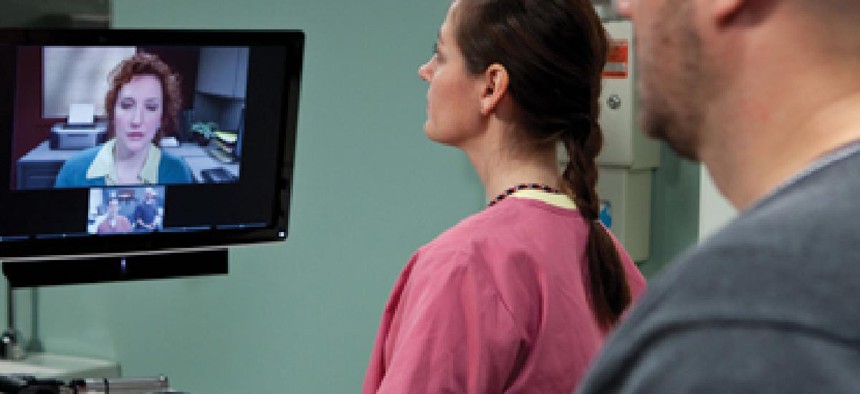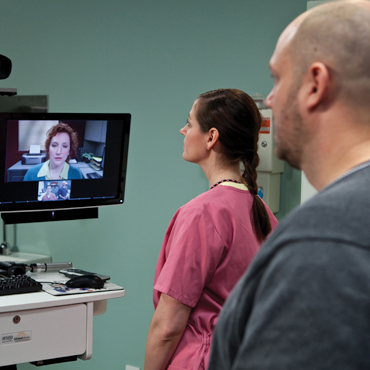How VA is driving telemedicine

The agency's scale, vision and customer base have put it on the leading edge. But that also means being the first to face technical and operational challenges.

The Department of Veterans Affairs uses videoconferencing to connect medical professionals across its network and enhance patient care.
There's a quiet revolution going on in health care that has big implications for the future of medicine.
Telemedicine, or the broader term telehealth, allows patients to receive medical examinations from primary care physicians, consult with specialists, participate in one-on-one psychotherapy or counseling, and share diagnostic information using videoconferencing and other electronic communications tools. It has mainly been used to reach those who live in rural areas, but its influence is spreading.
Although most of the technology underlying telemedicine is not particularly advanced, a confluence of circumstances is conspiring to take telemedicine out of the realm of specialized and rural care and into everyday programs. For instance, consumer devices such as the networked pedometer Fitbit are showing the public how monitoring and data-collection tools can be used to enhance health and fitness.
At a deeper level, changes in the law, pressure from insurance carriers to reduce hospitalizations, and a new emphasis on preventive care and disease management are combining to take telemedicine into the mainstream.
VA spurred by aging veteran population
When the history of telemedicine is written, significant credit will go to the Department of Veterans Affairs for leading the way in deploying telemedicine on a large scale. In fiscal 2013, more than 600,000 veterans accessed VA care using telemedicine programs -- for a total of more than 1.7 million episodes of care.
And the reach of VA's telehealth services is growing by about 22 percent a year. The agency is currently in the midst of a pilot program that allows veterans to enter vital information into an online tool that is accessible via mobile phones, tablets or desktop PCs to help their caregivers manage chronic conditions. VA is launching another service that allows larger, better-resourced hospitals to connect with smaller facilities to provide remote support for intensive care.
VA did not get into telemedicine out of an inherent interest in technology, said Dr. Adam Darkins, who leads national telehealth programs at the agency. Rather, VA officials wanted to help aging veterans with chronic disease live independently, for clinical and financial reasons. Although VA has a network of 152 hospitals and more than 1,100 other caregiving facilities, it still faced the problem of having to cover a lot of territory in terms of reaching veterans. Additionally, officials found that 45 percent of those requiring treatment resided in counties classified as rural by the U.S. Census Bureau.
So beginning in 2003, VA began a deliberate policy of building a national telemedicine program to expand its reach, reduce travel costs and increase the levels of care available to veterans.
VA runs three basic types of telemedicine programs: Clinical video is designed to replicate face-to-face interactions between caregivers and patients using videoconferencing; home monitoring allows doctors to keep tabs on patients with chronic conditions such as diabetes; and the teleradiology service on VA's My HealtheVet website allows clinicians to share imaging information on individual cases for help in diagnostics and care.
Increasingly, veterans of the wars in Iraq and Afghanistan are accessing telemedicine for mental health services, including treatment of post-traumatic stress disorder. Last year, VA tested a program that allows veterans to access those services from their homes via a secure video connection. It reached 2,284 veterans in the pilot phase, and Darkins anticipates reaching 7,000 this year as the program is expanded.
It poses some challenges from a network management perspective, said Peter Whitson, deputy executive director for enterprise systems engineering at VA's Office of Information and Technology. "Because it's video, it can be bandwidth-intensive," he said. "It also requires that we have in place sufficient management and monitoring tools and employing things like quality of service to make sure that other traffic doesn't diminish the quality of those video sessions. And that's a pretty big challenge on the scale that we have at VA."
Although such pilot projects are not predominantly about technology, Darkins stressed the importance of getting the clinical and IT people working together for a variety of reasons.
"It's not just a question of saying: Have we got the telecommunications and have we got the clinical model?" he said. "We then have to think about how we have to train the clinicians to be able to do it. We have to think about how we have to put help-desk support for both patients and clinicians in place. The volume of care we're providing is such that we're providing care that's mission critical, and we roll it out with that in mind."
The interoperability hurdle
The growing telemedicine industry is still working toward standardization and interoperability. VA, for instance, has the ability to videoconference at facilities linked across its wide-area network, but outside organizations sometimes have different standards and security requirements, which can make it difficult to operate on the same platform.
Darkins said remote monitoring devices have some standards for data elements related to vital signs, but there's still more work to be done. "My belief is…the device in the home needs to be standardized," he added.
Increased standardization and interoperability would pave the way toward the integration of telemedicine with electronic health records (EHRs), said Stewart Ferguson, CIO of the Alaska Native Tribal Health Consortium, a nonprofit organization based in Anchorage that provides health services to about 130,000 Alaska Natives and American Indians. He is a pioneer in developing telemedicine programs and related IT services.
Alaska is a special case when it comes to telemedicine. The average village has about 300 people and very few doctors or nurses. For such remote populations, it's often telehealth or no health care at all. Community health aides provide telemedicine services for communicating with general practitioners, and acute cases are sent to regional facilities or the state's medical center in Anchorage.
Ferguson imagines that in the not-too-distant future, an EHR system will be the platform on which telemedicine services run. Practitioners would have multimedia access to X-rays, stethoscope recordings and other patient information. The problem now is that doctors in the Alaska tribal health system have about 28 EHR systems in place, and they don't all talk to one another. The Health IT Act that was passed in 2009 as part of the broader economic stimulus package provides grants and other incentives to encourage medical practices to adopt EHR systems that adhere to federal standards. There's also a rather big penalty: Practices that have not done so by January 2015 face lower Medicare reimbursement rates.
EHRs that have some degree of interoperability with regard to patient records and communication among care providers will push industry in the direction of creating telemedicine standards across the board.
"Our goal is to make telemedicine and EHRs look like one system to the clinician," Ferguson said.
Congress gets into the act
Despite a range of technological and industry issues, the biggest impediments to telehealth are regulatory. State licensing requirements restrict treatment by out-of-state doctors even via telemedicine. One big reason VA has such an outsized influence on the development of telehealth is because its network of physicians are able to treat veterans throughout the system without regard to state licensing rules.
A few bills introduced in the House Energy and Commerce Committee are trying to simplify the delivery of telemedicine services across state lines. The Tele-Med Act, backed by Reps. Devin Nunes (R-Calif.) and Frank Pallone (D-N.J.), would allow Medicare recipients to seek telemedicine care from participating providers across state lines. For example, an elderly New Yorker who winters in Florida or Arizona would be able to receive care online from his or her regular physician.
The Telehealth Modernization Act, a companion bill backed by Reps. Bill Johnson (R-Ohio) and Doris Matsui (D-Calif.), would create a single, federal standard for telemedicine for use in national health care programs. And the Telehealth Enhancement Act from Reps. Gregg Harper (R-Miss.) and Peter Welch (D-Vt.) would expand reimbursement for telemedicine services under Medicare and Medicaid, mostly through pilot programs and narrowly defined circumstances. It would also amend the Communications Act to support health care providers under the universal service requirement.
It's not clear if any of those bills will pass, but the bipartisan focus on expanding telemedicine on that powerful committee indicates an interest in establishing some federal rules to make the patchwork of state laws more manageable for providers and insurance carriers. The Affordable Care Act has already established a number of key markers for the study of telemedicine as a care model, with the goal of evaluating effectiveness of treatment, cost savings, reduction in hospital readmissions and other factors.
In addition, the latest National Defense Authorization Act includes a provision that grants those leaving the military service and transitioning into civilian life an additional 180 days of telemedicine services on top of the 180 days of health coverage already issued under the Transitional Assistance Management Program.
The push for broadband access
Much of the infrastructure required to support telemedicine is in place. Although research and development predates fax machines and dial-up Internet, the growth of robust, high-speed broadband and the ubiquity of high-definition video technology have made access to telemedicine services a reality for millions of Americans. Tapan Mehta, global health care lead at Cisco Systems, told FCW that even relatively low broadband speeds of 1 to 2 megabits/sec are sufficient to handle videoconferencing and data transfers for teleradiology.
The Federal Communications Commission's Universal Service Fund has helped bring telecommunications connectivity to rural communities throughout America, and Ferguson said just about every village in Alaska takes advantage of the fund. The state has shifted from doing about 95 percent of its telemedicine via satellite to building a combination of fiber and microwave links, which means better bandwidth without the latency of satellite, he added.
Yet Whitson said there are still gaps in broadband services, and advocates at VA are pushing the FCC, the Agriculture Department's Rural Broadband Loan Program and other government programs to continue to fill out the national broadband map.
Even with high-speed broadband, network latency issues can limit performance. "It's just physics you're bound by," Whitson said, adding that VA's IT staff is focused on managing network congestion and making applications work at an optimal level. "Performance is something that we collectively focus on in a very significant way," he said.
Ferguson said providing tech support to rural areas is an added logistical challenge. In a remote Alaska village, a service call can begin with a $900 plane ticket, which makes sending an IT specialist an expensive proposition.
"It's not unusual for us to work with a health aide to help us do basic troubleshooting and do basic fixing on the network," Ferguson said. "If something is hard to use, we try to redesign it. Simplicity and reliability are the two main technical concerns for us."






